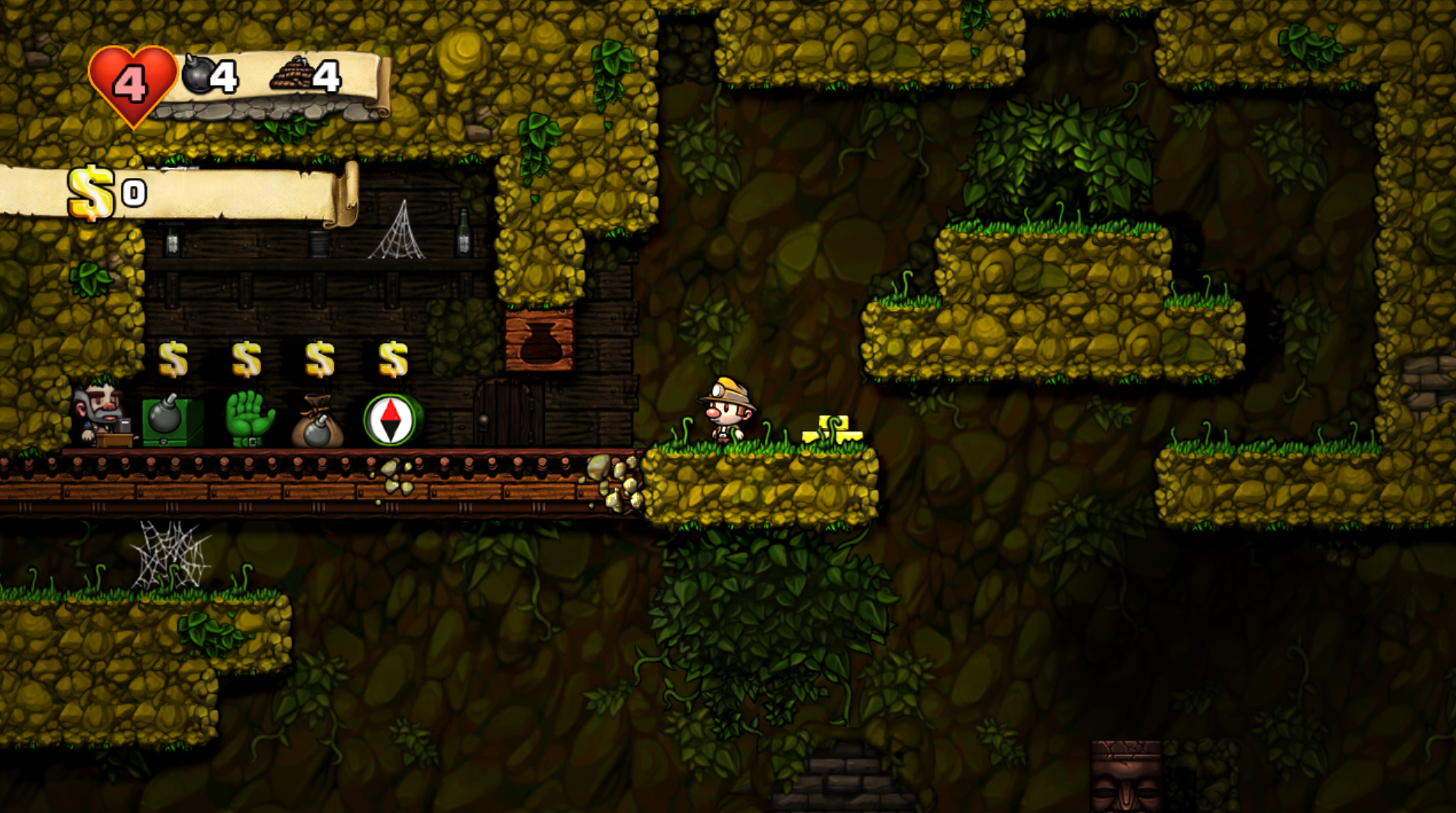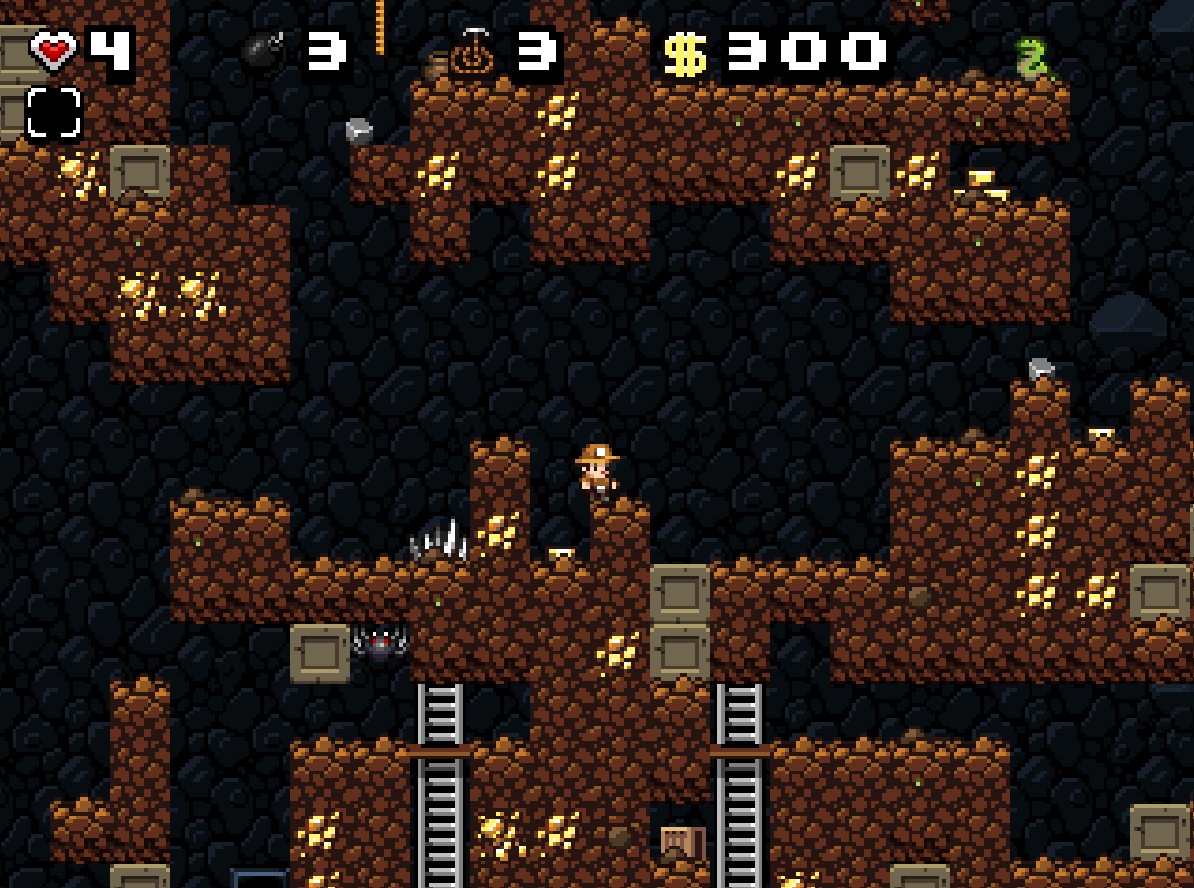
Spelunky HD is a video game developed by Derek Yu with programming by Andy Hull. It was initially released for the Xbox 360 in 2012 before being ported to many other platforms (“Spelunky Reviews - Metacritic”). It played a major role in popularizing randomly-generated environments in the game development community and was an early highlight of indie-games on consoles. Spelunky HD is a notoriously difficult platforming game which highlights destructible terrain and hidden game mechanics which the player can discover either through experimentation or by reading internet wikis.

Spelunky is influenced by past works and also serves as a hypotext for written works and modern-day video games. Additionally, it has been released in three separate versions and thus has influenced itself. Derek Yu initially shared Spelunky in 2008 on an internet forum called TIGSource. This version is referred to as Spelunky Classic. It was shared for free on the forum and was shaped by the feedback of other forum members in subsequent releases. This was the first form of participatory culture that the Spelunky project incorporated (“Spelunky v1.1 (and Source)!”).

Spelunky remixes some ideas from religion and folklore and presents them as game mechanics. All three iterations of Spelunky contain game object representations of altars to Kali, the Hindu “goddess of time, doomsday, and death” (Doniger). The player can gain favor with Kali by sacrificing certain game objects on the altars or can unleash a negative effect by destroying an altar with an explosion. Spelunky 2 contains a game object called Excalibur, a reference to the famous sword in the tales of King Arthur. This sword can be detached from a stone if the player has collected certain other items. Spelunky games pull from various mythologies and folklores to flesh out their libraries of game objects, some of which determine what level-types are accessible to the player later on.
For a number of people in my generation, Spelunky HD was the first time we saw random environment generation being employed in a traditional game. However, Derek Yu took underlying idea from previous works such as the 1980s video game Rogue. Rogue was one of the first games to introduce the idea that no two play environments would ever be the same, and through this concept it proposed a shift in the burden of the game developer: instead of having to hand-craft levels, the game developers’ job was now to create building blocks and rules for how they could be randomly combined together to make a near-infinite number of levels (Moss). Rogue’s ideas became so influential that the term “roguelike” is still often found in game descriptions written today.
Due to the nature of computers in the 1980s, game objects in Rogue are displayed to the user as keyboard symbols including letters, numbers, and other common marks (Moss). According to the youtube video “What is Semiotics?” by Occam's Answers, “because the meanings must be explicitly taught, symbols are easily misunderstood.” The disadvantage of Rogue’s symbols was that there was a high learning curve to understand what you were seeing on the screen. While a player would eventually learn to read the grid of symbols quite efficiently, the use of icons (signs which closely resemble what they represent) would lead to an easier pick-up-and-play experience.
According to Jodie from the youtube video “Immediacy Hypermediacy and Remediation Class Presentation”, “immediacy is how much the user or interacter forgets the medium in favor of the content or the task” (JayDoubleYa). Games like Spelunky tend to make the player aware of the mechanical systems that are controlling the game world, while also featuring high quality sprite artwork and sound effects which immerse the player. This juxtoposition of immersion and hypermediacy, emphasized by the wiki window the player might well have left open, leads to a dual experience which can sufficiently occupy a player’s mind to lead to a period of escapism. Yet another layer of hypermediacy can be added if the player streams to Twitch and has a simultaneous conversation with other strangers on the internet via Twitch chat.
The audience for Spelunky has been a mix of game developers and indie-game lovers, two groups who both like to develop games themselves. Recently we have seen some of these developers package this style of game in a more approachable way for a larger audience. In 2020 Supergiant Games released Hades, a top-down game that infused the genre with a ton of dialogue and story. Additionally, one of the earliest console-exclusive titles for the PlayStation 5 was Returnal by Housemarque. This game brought high-budget 3d graphics to the genre and marked one of the first major investments by a console maker in the roguelike genre. These games are only a tiny slice of the exploration that is currently being done by hundreds of developers in this space.
Video games are not the only form of media that has used Spelunky as a hypotext. Derek Yu’s sequel, Spelunky 2, was released in 2020, by which time the social streaming platform Twitch and the algorithmic forum Reddit were hugely popular and ready to ingest the new release that the audience had been waiting twelve years for. While Spelunky HD’s secrets had gradually been discovered over the course of many years, it only took about a month for the engaged streamers and Reddit data-analyzers to discover them all in the sequel. For a certain subset of video game players, Spelunky 2 marked the start of a months-long international community who developed podcasts, forums, videos, speedruns, and fan art for the new release.
In 2024, Amazon Prime Video published a TV adaptation of Spelunky for one episode of its series Secret Level (“Every Game has a Story”). This remediation was met with surprise from the gaming community because most of the other franchises incorporated by the show were by much larger software developers such as From Software or Epic Games. The episode was a shallow dive into the difference between death in the video game and what death might actually be like for a reincarnated human being. It felt to me like the creators had produced the beginning of an idea into an episode before it was ready. This was not a cohesive element of the Spelunky transmedia experience like its excellent fan art, mod scene, and figurines; instead, it was a bizarre ramification of the media convergence project Tim Miller and Amazon had embarked on. Video-based Spelunky art could work in the right context, but it will need to engage with the hypermediacy of the project and its community in a more interesting way.
One of the ways Spelunky 2 plays with hypermediacy is by requiring the use of the “journal menu” user interface element in order to reach the secret back half of the game. The journal menu was only a static informational library in the first two Spelunky games, but Spelunky 2 introduced a game object called “Tablet of Destiny” which has a description in the journal menu that actually varies between play sessions (“Tablet of Destiny (2).”). This variable description holds the clue required for finding a rideable creature called “Qilin” (from Chinese mythology) which allows the player to traverse a secret path.

Some artistic works aim to send a specific message to readers, while other works aim to give readers a world to explore. While the distinction is not cut and dried, I see Spelunky as more of an exploration-work for both the player and the developer. In an early trailer for Spelunky 2, Derek Yu stated “I think the great thing about Spelunky is that the deepest secrets are the ones that even I don’t know about” (PlayStation). Historically, developers have tried to avoid these moments and called them “glitches”, but new media video games like Spelunky have realized that unintended behavior can create lore and excitement for the player base. Instead of “glitches”, critics now often use the term “emergent behavior”, meaning a behavior emerging within the simulated world that the software developer did not realize would happen.
Spelunky HD’s release and popularity marked a significant moment in the ongoing exploration of developer control, player control, and simulated chaos. This conversation is more relevant than ever now that we have widely-used beta programs like Steam Early Access in which player feedback determines how a game is developed to an even larger degree. The conversation between these forces is not an argument, however, because there is audience demand for both constricted environments like a movie and engaging environments like a multiplayer game. In retrospect, what the Spelunky HD moment promised more than anything was that the video game industry was going to broaden and grow new subgenres more amenable to player-directed storytelling.
Doniger, Wendy. "Kali". Encyclopedia Britannica, 11 Feb. 2025, https://www.britannica.com/topic/Kali. Accessed 10 March 2025.
“Every Game has a Story - Prime Video Announces Premiere Date and First Teaser Trailer for New Adult-Animated Anthology Series Secret Level.” Amazonmgmstudios.com, 2024, press.amazonmgmstudios.com/us/en/press-release/every-game-has-a-story-prime-video-announces-premi. Accessed 10 Mar. 2025.
JayDoubleYa. “Immediacy Hypermediacy and Remediation Class Presentation.” YouTube, 22 Aug. 2007, www.youtube.com/watch?v=ZE167KUiM5E. Accessed 10 Mar. 2025.
Moss R. C. “ASCII Art + Permadeath: The History of Roguelike Games - Ars Technica”. Arstechnica, 19 Mar. 2020, https://arstechnica.com/gaming/2020/03/ascii-art-permadeath-the-history-of-roguelike-games/.
Occam's Answers. “What Is Semiotics?” YouTube, 16 Nov. 2017, www.youtube.com/watch?v=R7VA95JdbMQ.
PlayStation. “Spelunky 2 - State of Play Release Date Trailer | PS4.” YouTube, 6 Aug. 2020, www.youtube.com/watch?v=3gc1xuzHIDs. Accessed 10 Mar. 2025.
“Spelunky Reviews - Metacritic”. Metacritic, https://www.metacritic.com/game/spelunky/. Accessed 10 Mar. 2025.
“Spelunky v1.1 (and Source)!”. TIGSource Forums, https://forums.tigsource.com/index.php?topic=4017.0. Accessed 10 Mar. 2025.
“Tablet of Destiny (2).” Spelunky Wiki, Fandom, Inc., 2025, spelunky.fandom.com/wiki/Tablet_of_Destiny_(2). Accessed 10 Mar. 2025.